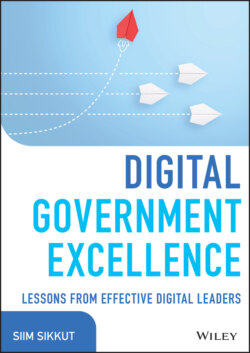Читать книгу Digital Government Excellence - Siim Sikkut - Страница 25
How Did You Embrace New Things That Must Have Emerged along the Way? Did You Ever Adjust the Strategy?
ОглавлениеNew things did emerge along the way, such as blockchain and AI, that came from nowhere to the picture. We needed to make sure to plug them with the other stack we were building up. It was easier because we had different teams running different projects, so focus and delivery of overall strategy did not suffer. For example, we had a special team looking at next technologies and scanning the horizon—next to the backbone team, the data team, the strategy team.
Blockchain is a good example of how we adjusted our strategies. We first took it to testing in the Future Accelerator that the Executive Office had set up to embrace new technologies and have Dubai as a hub to implement all these new ideas. We took a small project to see if blockchain could actually help us. The project was about converting all the settlement and reconciliation of the government accounts into the blockchain platform. Citizens pay all public bills to one unified count; the government distributes it in the back end. We got a small start-up from Dubai to help us, and they took a previous forty-five-day process down to a zero-time settlement. A great gain in efficiency.
We took that example and started mapping all the use cases across the government that blockchain could be applicable for, plus we did desktop research and study visits to see how other countries had done it. We mapped some forty use cases and ended up putting a deadline of two years to implement everything in our government with blockchain. Then we found through the implementation that not everything can be applicable for blockchain. So, we changed the direction of our strategy and focused on applicable services only. In this work, we also saw we needed to design procedures, policies, and regulation—for example, for operating a unified blockchain platform for the government.
You see how new directions started from having a team scanning the horizon. They had to suggest a proper strategy, a plan of execution for experimentation. Based on this we could plug it into the existing strategy or road map on a yearly basis.
At the end of every year, we would sit with SDO management team and revisit our strategy to reflect the changing realities. Such reauthorization of strategy was also important because our understanding of what a smart city is would evolve. Every year, we would start to understand more and become more mindful about what can be successful and what cannot be done. This openness and transparency to be able to reshape made the strategy all the more applicable to be implemented—rather than having a very nice, shiny strategic document only.
Many organizations shy away from revisiting their strategy, because they think it might imply that they did not understand what they put in the strategy before. Instead, the revisiting means we understand better now because of our experience! That is why we made the revisiting mandatory.
It was done as a three-day retreat with all the directors in the organization. The one condition to be there was to remove your heart from the department you were in. I did not want any emotional attachment to any projects when entering that room. Otherwise, if we decided to pause some projects, the people leading would feel we did not want them—which was not the case.
